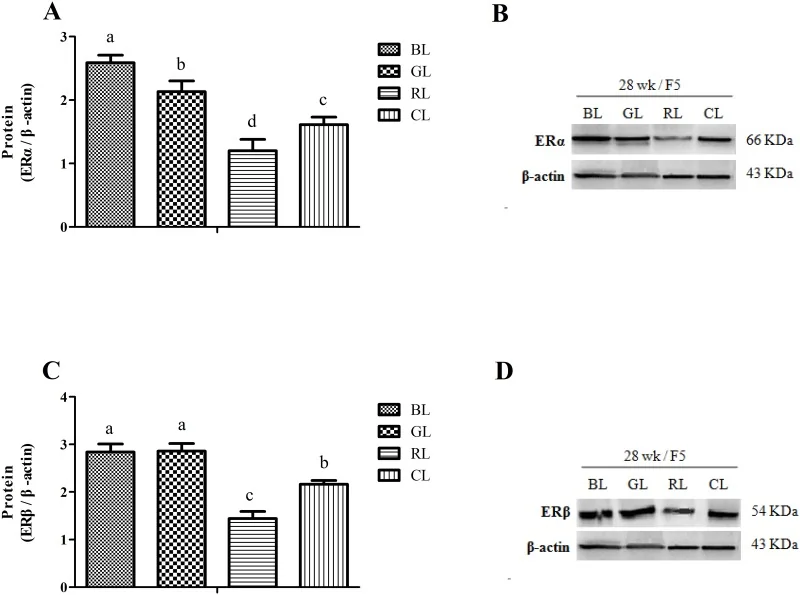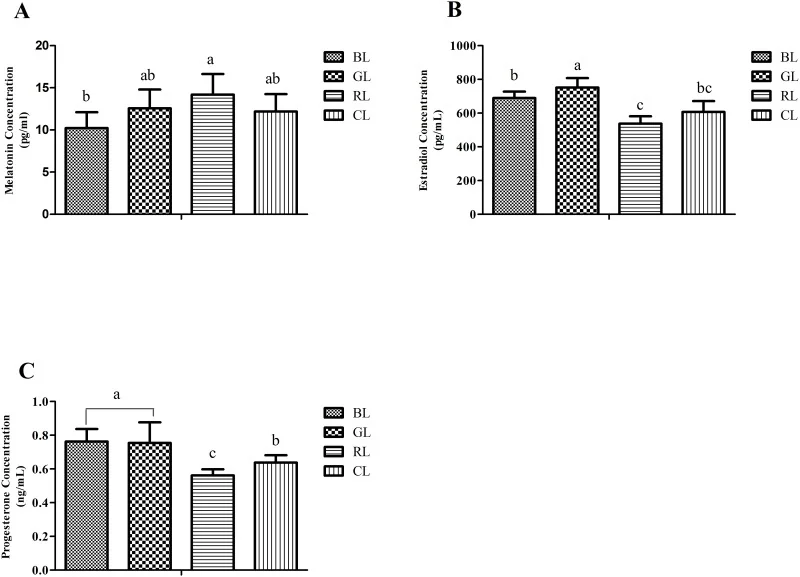Red light (660nm) is anti-estrogenic; lowers estradiol and estrogen receptor expression; blue light is estrogenic.
-
After bathing all weekend in 2 150W infrared heat lamps positioned 15–20 cm from my head and using a strong red light filter on my phone and screen, I noticed a significant boost in my well-being and skin health. However, I was surprised to experience a sharp decrease in libido—similar to the effects of excessive anti-estrogenic substances.
This prompted me to research the hormonal effects of different wavelengths of light. I came across a rodent study where chickens exposed to a very dimly lit room with either blue, green, red, or clear white light experienced significant changes in estradiol and progesterone levels & receptor expression.
They exposed these chickens to very low levels of either blue, green red or clear white light (15 flux, your average office building is 300 - 500 flux and a room next to a window can have 1000+ flux) for 12 hours a day. The effects on estradiol levels were moderate, with the red and clear white light group showing moderately suppressed estradiol levels compared to blue and green light. However, what was interesting was that, The red light group had less than 50% of the estrogen receptors compared to the blue light group (whereas the blue light group showed 100%+ more estrogen receptors).
The mechanism of action likely relates to how wavelengths of light above 500nm (green, yellow, orange, red, infrared) stimulate the mitochondria/metabolism as well as dopamine synthesis, both of which are anti-estrogenic.
It’s pretty clear that blue light has estrogenic effects, so it makes you wonder—what happens when we spend eight hours a day under fluorescent lights? They’re packed with blue light and a magnitude of several hundred times brighter than the lights used in this study. If one works at home / can customise their office, one can replicate this studies design very easily by putting some strong, warm incandescent lights or some red LED lights in the office.
It’s worth noting that red, green, and clear white light also suppressed progesterone levels and progesterone receptor concentrations—but to a much lesser extent than estrogen. So they will move the body away from estrogen dominance, and towards progesterone.
https://pmc.ncbi.nlm.nih.gov/articles/PMC4666490/

Effects of blue (BL), green (GL), red (RL) and clear light (CL) on estrogen alpha & beta concentrations

Effects of blue(BL), green(GL), red (RL) and clear light(CL) on estradiol, progesterone and melatonin levels."Treatment with BL increased ERβ mRNA in granulosa layers of F5, F3 and F1, while GL increased ERβ mRNA in F5 and F3....These results indicate that blue and green monochromatic lights promote egg production traits via stimulating gonadal hormone secretion and up-regulating expression of ERs and PRs."
"Plasma estradiol was elevated in the GL laying hens, with the lowest estradiol in birds reared under RL (P < 0.05) (Fig 2B)* GL and BL increased plasma progesterone relative to CL and RL at 28 wk of age (P < 0.05) (Fig 2C)....There was greater ERα or ERβ protein in BL and GL than CL, and lowest amounts of protein in the RL group."
-
@alfredoolivas people in south asia really like blue indoor lighting, even to the extent ive talked to some lighting guys in north america and they say brown people always get their house indoor lights done in blue. this might explain the general chaos, estrogenicity, and other issues in places like Pakistan and India.
-
This post is deleted! -
Red light (660nm) therapy has shown anti-estrogenic effects, helping lower estradiol levels and reduce estrogen receptor expression. On the other hand, blue light tends to have estrogenic properties. Understanding these effects can help optimize light therapies, and tools like rslhelper can make tracking and analyzing such health data much easier!
-
Nice thanks for sharing!
-
First, Thank you for sharing your story and the results of your subsequent research.
Percentages can be confusing and I am glad that you included an image which showed the magnitude of the actual changes. From the image, it appears that the clear light (CL) is a fair reference for evaluating absolute changes.
Red light (RL) produced a 50% reduction from CL. And blue light produced a 50% increase from CL.
@alfredoolivas said in Red light (660nm) is anti-estrogenic; lowers estradiol and estrogen receptor expression; blue light is estrogenic.:
The red light group had less than 50% of the estrogen receptors compared to the blue light group (whereas the blue light group showed 100%+ more estrogen receptors).
The numbers you provided are correct, but for me their magnitude distort the findings in the image. Your numbers compare the consequences of choosing RL over BL or vice versa. 50% equals 100% if you reverse the order in the comparison.
-
@DavidPS ahhh so the clear light was the control ! I was thinking it’s a shame there wasn’t a control, but it turns out there was. Thanks David.
-
@alfredoolivas - We both wondered about the control.

The anti-estrogenic effect of red light is amazing. I had been thinking about red light and the minimum exposure that is needed to provoke a response in mitochondria. (See Just 1 minute of red light is effective) This thread inspired me to talk a long walk outside. Where I live the sun is not high enough in the sky for me to be able to make vitamin D; but I can still benefit from the anti-estrogen effects.
-
Red light is a top 3 topic Ray touched on. Yea I know he didn't invent nor was he a pioneer, but he highlighted the importance of light balance, exposing a huge rabbit hole for anyone to jump in.
Set up a red incandescent strip years ago and never looked back.